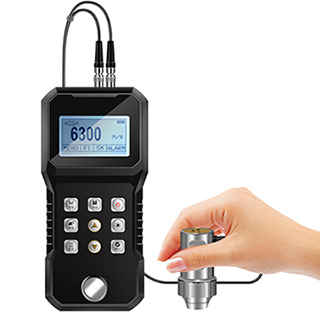Ultrasonic thickness gauge working principle
Ultrasonic thickness gauge mainly adopts the principle of ultrasonic pulse reflection method to measure the thickness of materials and objects conveniently and quickly, so as to realize the most basic thickness measurement function.
Ultrasonic thickness gauge applications
Ultrasonic thickness gauge is mainly used to detect hard materials (steel plates, glass, etc.). However, soft materials (such as sofas, sponges, etc.) cannot be measured with an ut thickness gauge. In addition, when testing the thickness of the material, attention should be paid to the sound velocity of the material being measured. The sound velocity of different materials is different.
Ultrasonic thickness gauge can be used to measure the accuracy and thickness of various plates and various processed parts, and can also be used to monitor various pipes and pressure vessels in production equipment. It can be used to monitor the degree of thinning after corrosion during use. Therefore, the ultrasonic thickness gauge can be widely used in petroleum, metallurgy, chemical industry, shipbuilding, aviation and other fields.
The four measurement methods of ultrasonic thickness gauge
- General measurement method: It is required to make two thickness measurements with the probe at one point. In the two measurements, the dividing plane of the probe of the ultrasonic thickness gauge should be 90° to each other. The smaller value is the thickness of the measured workpiece.
30mm multi-point measurement method: When the measured value is unstable, it is necessary to make multiple measurements in a circle with a diameter of about 30mm with a measurement point as the center. The minimum value is the thickness of the measured workpiece. - Precise measurement method: It is required to increase the number of measurements around the specified measurement point. Thickness changes are represented by contour lines.
- Continuous measurement method: It is required to use the single-point measurement method for continuous measurement along the designated route, and the interval is not more than 5mm.
- Grid measurement method: This method refers to drawing a grid on a designated area and recording the thickness by point. This solution is widely used in the corrosion monitoring of high-pressure equipment and stainless steel linings.
Ultrasonic thickness gauge measurement
- Investigate the site, understand and master basic data such as the surface condition, pipe diameter, and original wall thickness of the site facilities.
- Workers need to wear special work clothes, insulating shoes, protective gloves and other labor protection products that meet professional protection requirements. If there are serious rust layers, adherents, delamination paint, sharp particles, etc. on the surface of the thickness measurement part, it needs to be cleaned and polished until it is clean and smooth. It is necessary to uniformly number the thickness measurement parts and spray the measurement point marks on the surface of the on-site facility.
- The temperature of pipeline facilities needs to be checked. The thickness measurement of the high temperature inspection point requires a high temperature measuring probe. So when you buy thickness gauge from Tool.com, you should also choose the right probe for your needs.
- Wear a protective mask in the area with hazardous gas. When the height of the site operation exceeds the safety regulations, scaffolding should be erected and the staff should wear safety belts.
- Measurement correction. There are two ways to calibrate: One is calibration with standard test blocks, and the other is calibration by setting the speed of sound. Calibration with standard test block: Single-point calibration. Calibration in this mode can only be performed when the 2-PT (dual-point) mode is "OFF", that is, press the "MODE" key until "THK" is displayed. Press the "CAL/ON" key, and "CAL" starts to flash. During this period, it is necessary to couple the probe with the calibration reference block. When the coupling indicator lights up, the reading is stable. At this time, the displayed value may not match the known thickness of the calibration test block. At this time, the probe can be kept coupled and the probe can be removed. Use ▲ and ▼ to adjust the displayed value to make it consistent with the thickness of the calibration test block. Then press the "CAL/ ON" key again to complete the calibration.

